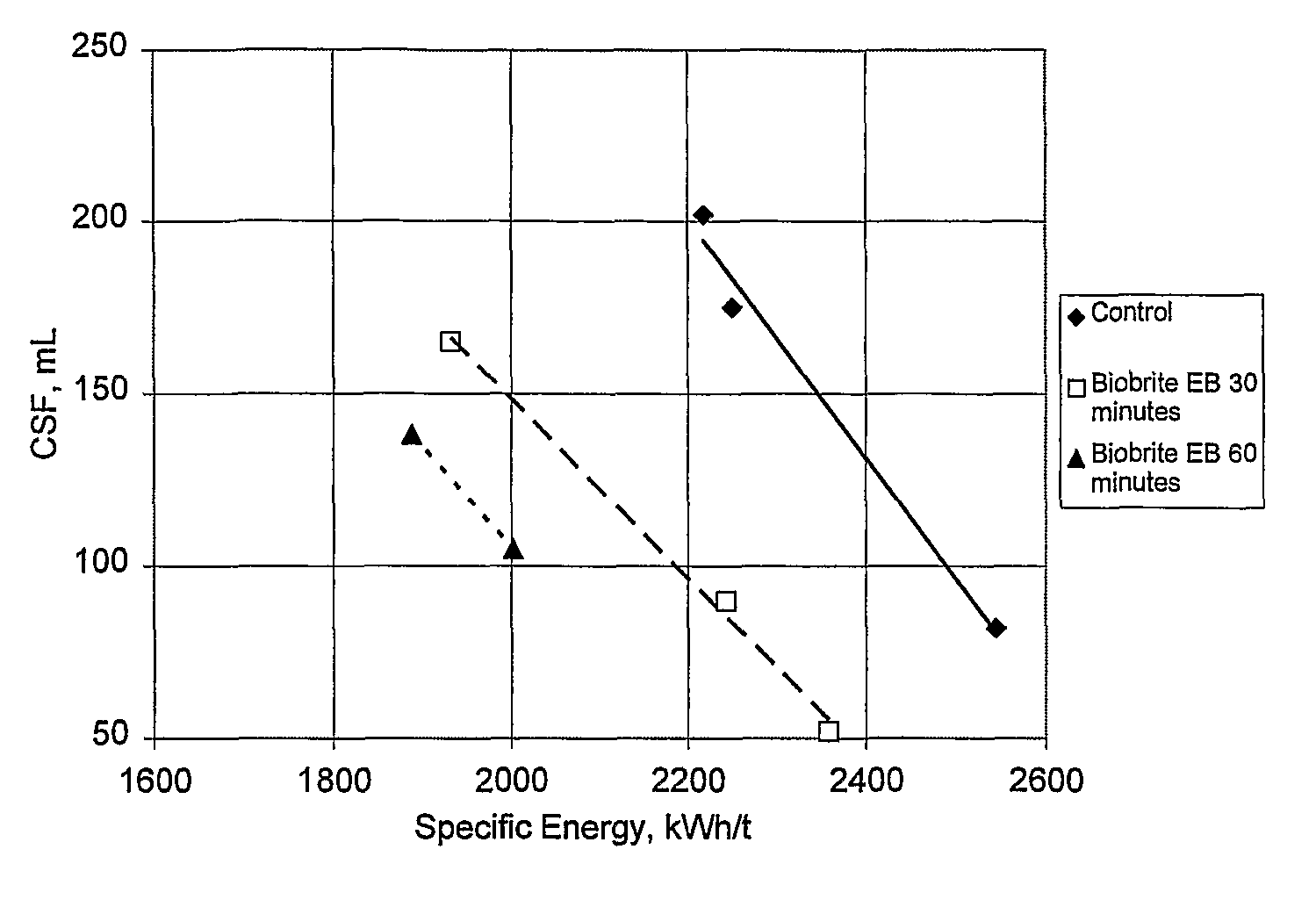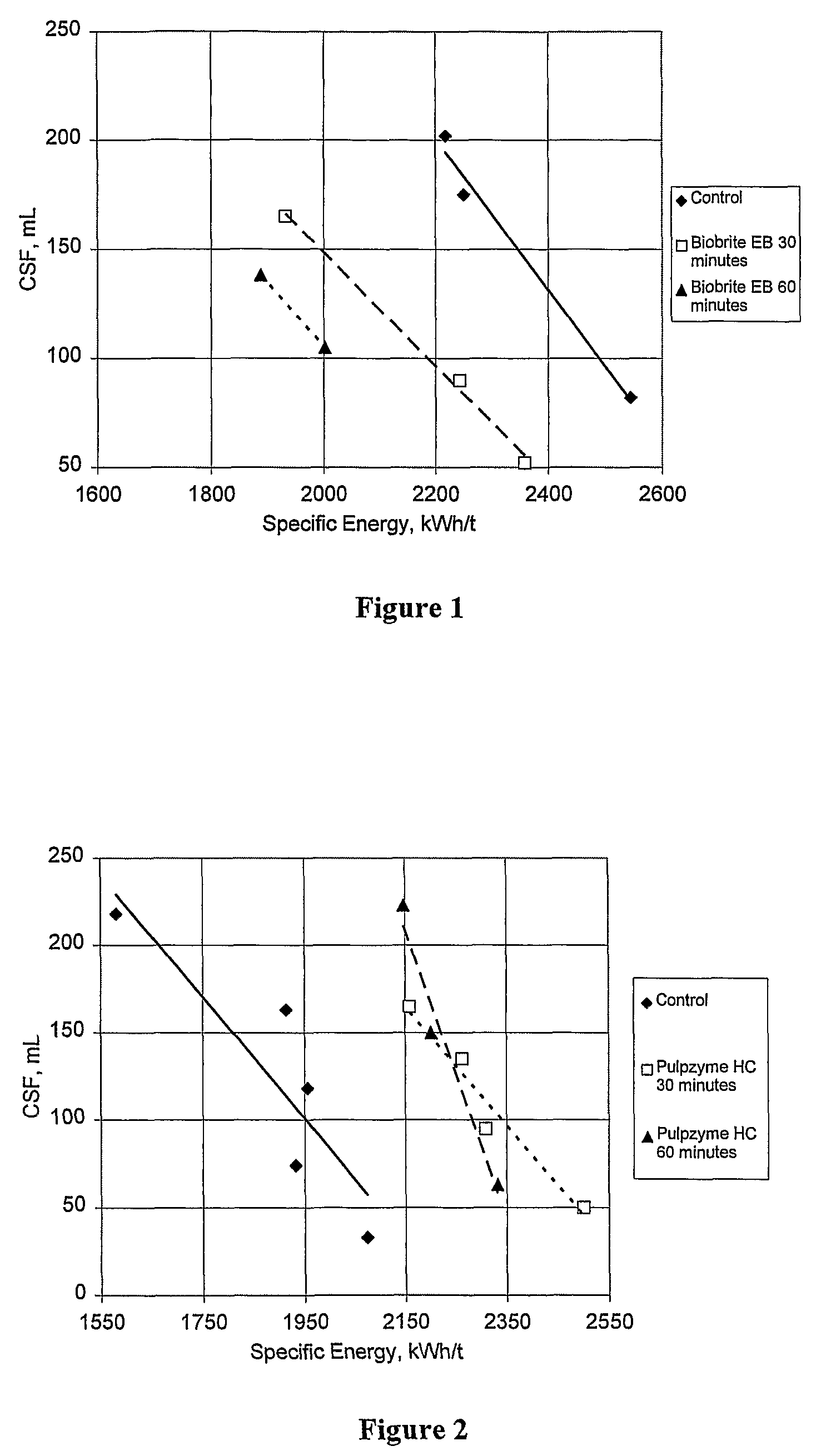Method for mechanical pulp production
a mechanical pulp and production method technology, applied in the field of mechanical pulp production, can solve the problems of reducing the competitiveness of the pulp in some applications, increasing the cost of electricity, and high cost, and achieves the effect of reducing the energy consumption of the refiner, reducing the cost of electricity, and increasing the refining energy
- Summary
- Abstract
- Description
- Claims
- Application Information
AI Technical Summary
Benefits of technology
Problems solved by technology
Method used
Image
Examples
example 1
Determination of Protein Concentration of Xylanase Solutions
[0081]The protein concentrations of the xylanase mixtures were determined by the Bio-Rad / Coomasie method wherein the protein in solution was treated with Coomassie Brilliant Blue dye to form a colored complex. The absorption of light at 595 nm was measured and the amount of enzyme determined in comparison to a standard cellulase enzyme treated as the protein solution. The protein in the xylanase mixtures was comprised of at least 70% xylanase protein.
example 2
Standard Assay for the Measurement of Xylanase Activity
[0082]The endo xylanase assay is specific for endo-1,4-beta-D-xylanase activity. On incubation of azo-xylan (oat) with xylanase, the substrate is depolymerized to produce low-molecular weight dyed fragments which remain in solution on addition of ethanol to the reaction mixture. High molecular weight material is removed by centrifugation and the colour of the supernatant is measured. Xylanase activity in the assay solution is determined by reference to a standard curve. The method is based on that published by Megazyme International Ireland Limited (2003) and the product name is S-AXYO oat Azo-Xylan. The substrate is purified (to remove starch and beta-glucan). The polysaccharide is dyed with Remazolbrilliant Blue R to an extent of about one dye molecule per 30 sugar residues.
[0083]The powdered substrate is dissolved in water and sodium acetate buffer and the pH adjusted to 4.5 to provide a final solution having a concentration ...
example 3
Determination of Amount of Xylan and Xylose Released by Xylanase Treatment
[0086]The quantity of xylose released by the treatment of chips with a xylanase enzyme in laboratory studies is determined as follows. First, a chip suspension is treated with enzyme in a polyethylene bag for 60 minutes at a solids consistency of 5.0%, a temperature of 63° C. and a pH of ˜5.7 to 6.3. The pH of the pulp suspension is adjusted adding either 0.1 N caustic if he suspension is too acidic or 0.1 N sulfuric acid if the solution is too alkaline. Prior to adding the xylanase enzyme to the chips, the chip sample is pre-heated to the desired temperature in a thermostatic water bath so as to emulate operation in a mill, where enzyme is added to hot chips. A chip control sample is treated in exactly the same manner as the xylanase treated chips, except that water is used in place of a xylanase preparation, which is equivalent to a dosage of 0 XU / g pulp. After treatment, each chip suspension is filtered usi...
PUM
| Property | Measurement | Unit |
|---|---|---|
| temperature | aaaaa | aaaaa |
| pH | aaaaa | aaaaa |
| temperature | aaaaa | aaaaa |
Abstract
Description
Claims
Application Information
 Login to View More
Login to View More - R&D
- Intellectual Property
- Life Sciences
- Materials
- Tech Scout
- Unparalleled Data Quality
- Higher Quality Content
- 60% Fewer Hallucinations
Browse by: Latest US Patents, China's latest patents, Technical Efficacy Thesaurus, Application Domain, Technology Topic, Popular Technical Reports.
© 2025 PatSnap. All rights reserved.Legal|Privacy policy|Modern Slavery Act Transparency Statement|Sitemap|About US| Contact US: help@patsnap.com



